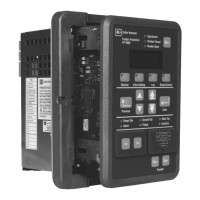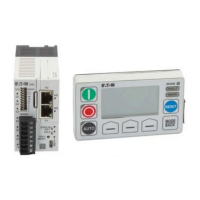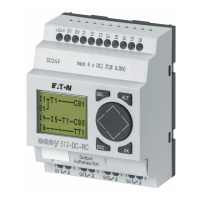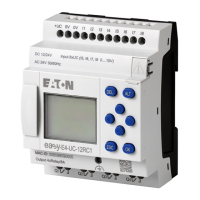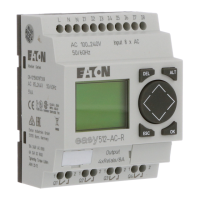I.L. 17562
Page 93
PR 0.3 Effective 8/99
operation above UTC. Make sure the winding direct thermal trip temperature setting (WD T) is
not turned OFF, or the algorithm reverts to strict use of UTC.
9.1.3.4 Underload Functions — When the motor is running, a current reduction might indicate
a malfunction in the load. Underload protection recognizes mechanical problems, such as a
blocked flow or loss of back pressure in a pump, or a broken drive belt or drive shaft.
Refer to the underload protection limit - the left vertical line - in the Underload–Jam Protection
Curve example of Figure 9.3. Here, the underload trip is set at 60% of FLA. The MP-3000 has
setpoints for underload alarm (ULA, P4L5), and underload trip (ULT, P3L9). Each can be
disabled by setting to OFF. These would be represented by two such vertical lines, both below
the normal load current. Be sure to set the alarm level above the trip level. Both trips and
alarms are held off by start delay ULSD, P3L10. Each has its own run or pickup delay - ULTR,
P3L11 and ULAR, P4L4. Use the start delay to block tripping until the load stabilizes after a
start; and use run delays to avoid nuisance alarms or trips for load transients.
9.1.3.5 Jam Functions — When the motor is running, a current increase way above normal load
might indicate a malfunction in the load. Jam protection recognizes mechanical problems, such
as broken drive gears.
Refer to the jam protection limit - the right vertical line - in the Underload–Jam protection curve
example of Figure 9.3. Here, the jam trip is set at 150% of FLA. The MP-3000 has setpoints for
jam alarm (JMA, P4L3), and jam trip (JMT, P3L6). Each can be disabled by setting to OFF.
These would be represented by two such vertical lines, both well above the normal load current.
Be sure to set the alarm level below the trip level. Both trips and alarms are held off by start
delay JMSD, P3L7. Each has its own run delay - JMTR, P3L8 and JMAR, P4L4. Use the start
delay to block tripping until the motor current drops to continuous load level; and use run delays
to avoid nuisance alarms or trips for load transients.
9.1.4 Complete Motor Protection Curves — To illustrate the protection features of the
MP-3000, two sample curves are shown. Using specific motor data, typical motor protection
curves for the MP-3000 without RTDs are shown in Figure 9.4. The use of RTDs is assumed in
Figure 9.5. The following data were used:
• Balanced currents during start and run cycles.
• Instantaneous overcurrent limit IOC of 12 times FLA
• Locked-rotor amperes of 6.1 times FLA
• Maximum allowable stall or locked-rotor time of 15 seconds, cold start
• Ultimate trip level of 100 percent of FLA (service factor = 1.0)
• Motor running; normally loaded at 90 percent of FLA
• Underload protection at 60 percent of FLA with a 5-second run delay
• Jam protection at 180 percent of FLA with a 5-second run delay
The MP-3000 recognition of the transition from start to run has no impact on this protection
curve, but defines when the displays and indications change from START to RUN. For a
reduced-voltage starter, the transition function also defines when the AUX2 output relay switches
the starter from reduced to normal running voltage. See 9.2.1 below. The user might elect to
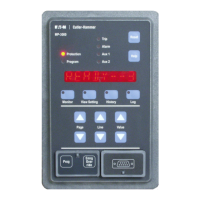
